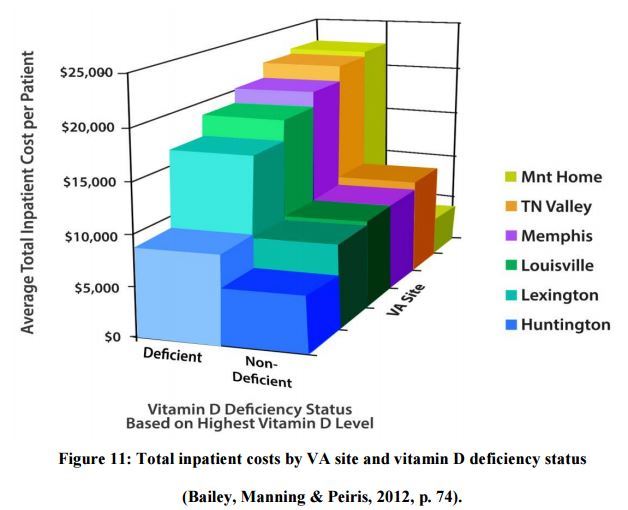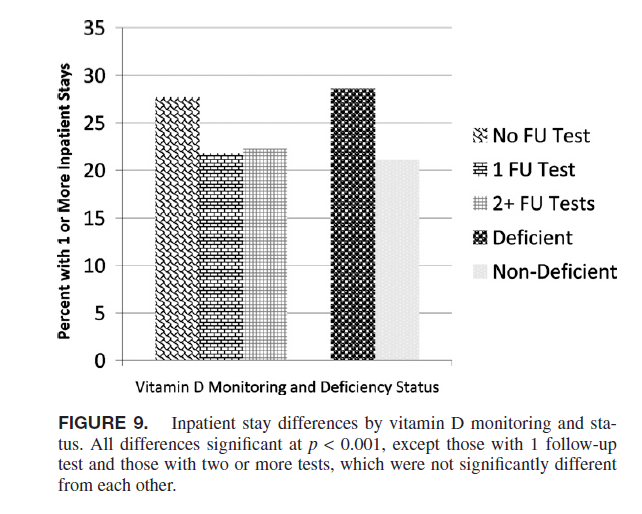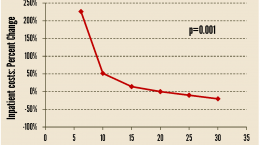Published on September 6, 2019
Researchers in Tennessee believed that vitamin D deficiency could lead to chronic ailments, which in turn increases health care costs. The Veterans Administration is interested not only in the health of their veterans, but also in reduced costs associated with fewer visits to the VA, and lower incidence of disease.
 Without clear guidelines within the VA for vitamin D testing and monitoring, the researchers hypothesized that there would be differences in vitamin D testing and vitamin D status, and those differences would be associated with differences in overall health care costs. They looked at data from 6 different Southeastern VA Medical Centers where vitamin D testing had been in place from October 2004 to December 2008. This included 400,000 patients of which 15,340 had vitamin D tests within their records.
Without clear guidelines within the VA for vitamin D testing and monitoring, the researchers hypothesized that there would be differences in vitamin D testing and vitamin D status, and those differences would be associated with differences in overall health care costs. They looked at data from 6 different Southeastern VA Medical Centers where vitamin D testing had been in place from October 2004 to December 2008. This included 400,000 patients of which 15,340 had vitamin D tests within their records.
They defined vitamin D deficiency as 25(OH)D below 20 ng/ml (50 nmol/L).
What did they find?
For those patients with vitamin D test results, roughly 30-50% were vitamin D deficient on their initial test. The VA center with the lowest percentage of vitamin D deficiency also had more than 50% lower inpatient costs than the three centers with the highest rates of vitamin D deficiency. Also, patients who received one or more follow-up tests (which gives the patient data required to maintain their optimal vitamin D level) had 50% lower inpatient laboratory and pharmacy costs, as compared to those that only received one test.

They also measured what they called service utilization, which included the number of hospitalizations and the length of those hospital stays. Presumably, the healthier the person, the shorter their stay in the medical center. They found deficient patients were not only more likely to have an inpatient stay, but also to have a longer stay than their sufficient counterparts.

They compared patients who were both deficient and never had a follow-up test with those who were only deficient or had no follow-up test and those who were both sufficient and had at least one follow-up test. The former group had 70% higher total inpatient costs than the middle group, and almost 300% higher costs than the latter group. It is best to be sufficient, but what is also important is to get follow-up tests so that you can determine if what you are doing is working.
Conclusion
This study proposed that as a standard practice, vitamin D levels should be checked once or twice a year until they are stable at the desired level.
“We recommend protocols that recognize site differences and facilitate testing and monitoring of vitamin D levels, especially in high-risk groups of veterans.”
Once a vitamin D level has been measured, the correct dose for supplementation can be calculated, and re-testing the vitamin D level can confirm if that supplementation amount is enough to reach a target vitamin D level, or if adjustments are needed. Detailed steps on how to reach your target vitamin D level can be found here. The GrassrootsHealth Nutrient Research Institute Scientists’ Panel recommends a target vitamin D level between 40-60 ng/ml (100-150 nmol/L).
GrassrootsHealth believes this should be applied to all populations, and has worked with institutions to implement with pregnant women through our Protect our Children NOW! nutrient field trial.
Are you getting enough vitamin D?
Testing your vitamin D level regularly and taking daily steps to keep it at a target level of 40-60 ng/ml (100-150 nmol/L) is important for all stages of health. Find out your levels today! Log on to the shop (click the link below) to get your tests and see for yourself if your level can be improved.
Make sure you track your results before and after, about every 6 months!
How can I track my nutrient intake and levels over time?
To help you track your supplement use and nutrient levels, GrassrootsHealth has created an online tracking system called myData-myAnswers. For each specific supplement, you can track what days you take it, how much, and many other details. This will help you know your true supplemental intake and what patterns of use work for you to reach and maintain optimum nutrient levels. Check it out today!






